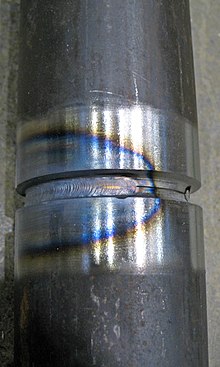Heat-affected zone


In fusion welding, the heat-affected zone (HAZ) is the area of base material, either a metal or a thermoplastic, which is not melted but has had its microstructure and properties altered by welding or heat intensive cutting operations. The heat from the welding process and subsequent re-cooling causes this change from the weld interface to the termination of the sensitizing temperature in the base metal. The extent and magnitude of property change depends primarily on the base material, the weld filler metal, and the amount and concentration of heat input by the welding process.
The
electron beam welding give a highly concentrated, limited amount of heat, resulting in a small HAZ. Arc welding
falls between these two extremes, with the individual processes varying somewhat in heat input. To calculate the heat input for arc welding procedures, the following formula is used:
where Q = heat input (
kJ/mm), V = voltage (V), I = current (A), and S = welding speed (mm/min). The efficiency is dependent on the welding process used, with gas tungsten arc welding having a value of 0.6, shielded metal arc welding and gas metal arc welding having a value of 0.8, and submerged arc welding 1.0.[1]
References
- Weman, Klas (2003). Welding processes handbook. New York: CRC Press LLC. ISBN 0-8493-1773-8.

